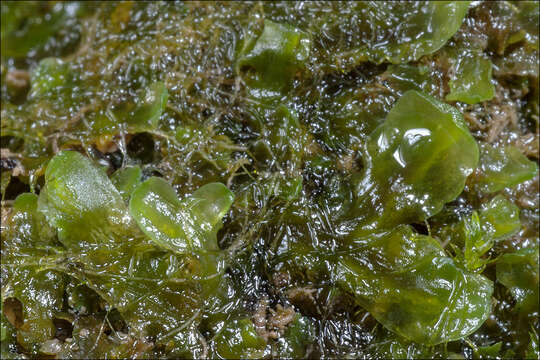Pellia-epiphylla_15

Description:
Pellia epiphylla (L.) Corda, syn.: Blasia epiphylla (L.) Fr., Marsilia epiphylla (L.) Lindb.EN: Common Liverwort, Common Pellia, Overleaf Pellia, DE: Gemeines BeckenmoosSlo.: navadni jetrnjakDat.: Feb. 13. 2008Lat.: 46.12988 Long.: 13.81285Code: Bot_0240/2008_DSC5176 and Bot_0241/2008_DSC5245Habitat: mixed forest; moist, right bank of a narrow mountain ravine; steep mountain slope, southeast aspect; mostly in shade; average precipitations 2.000-2.600 mm/year, average temperature 10-11 deg C, elevations 470 m (1.550 feet), prealpine phytogeographical region. Substratum: rocky, almost vertical surface with a thin layer of clayey soil.Place: Next to the trail from village Slap ob Idrijci to village Ponikve; the ravine of Kostanjevica creek, East Julian Pre-Alps, Posoje, Slovenia EC. Comment: Pellia epiphylla is a foliose species of liverworts (Marchantiophyta). These geologically very old creatures also belong to the kingdom of plants (Plantae), but are morphologically and functionally much different. Pellia epiphylla is like a 'double kind' of living being. The first one (gametophyte) reproduces sexually. It has separate male (antheridia) and female (archegonia) sex organs. In this form the species consists of green, foliose thalli of rather poorly defined shapes measuring up to 1 cm across and bearing both sex organs on the upper side of the thalli (not shown on my pictures). In wet weather sperms float around and eventually fertilize ova. The fertilized ova develop into the second form of this plant (sporophyte) in the shape of small, brownish cups (see Fig.5), which remain attached to the sexual green thalli of the gametophyte. This form proliferates on a non-sexual way producing spores like mosses, fungi and ferns. The sporophytes produce long, translucent 'stalks' (setae) with dark, shiny, spherical capsules on top (Fig. 2, 3). When they become mature, they burst and their cuticle peels back into four brownish segments. Light ocher-brown tufts of 'hairs' (elaters) and spores appear. Elaters mechanically change their shape depending on environmental conditions, particularly regarding air humidity, and hence ensure that the spores are dispersed only in favorable conditions. When the spores germinate, new gametophytes are produced and the life circle is closed.Pellia epiphylla is morphologically very similar to Pellia neesiana. The latter one is a dioicous plan (separate plants bearing male only or female only sexual organs) in contrast to Pellia epiphylla, which is a monoicous plant (male and female organs reside on the thallus of the same plant). Hence, thali of sterile plants (still without sexual organs) of both species are generally (without microscopy) indistinguishable (which may apply also to this find). Linn described Pellia epiphylla already in 1757. It is a very common liverwort species living in all colder regions of north hemisphere on permanently moist places. In spite of this most people have never even heard of it. Ref.:(1) Ian Atherton, Ed., Mosses and Liverworts of Britain and Ireland - a field guide, British Bryological Society (2010), p 235. (2) www.gbif.org/species/2689550 (accessed Feb. 23. 2019)(3) V. Wirth, R. Duell, Farbatlas Flechten und Moose, Ulmer, (2000), p 193.
Included On The Following Pages:
- Life (creatures)
- Cellular (cellular organisms)
- Eukaryota (eukaryotes)
- Archaeplastida (plants)
- Chloroplastida (green plants)
- Streptophyta
- Embryophytes
- Marchantiophyta (liverworts)
- Jungermanniopsida
- Pelliidae
- Pelliales
- Pelliaceae
- Pellia
- Pellia epiphylla (overleaf pellia)
This image is not featured in any collections.
Source Information
- license
- cc-by-nc-sa
- copyright
- Amadej Trnkoczy
- photographer
- Amadej Trnkoczy
- original
- original media file
- visit source
- partner site
- Flickr Group
- ID


